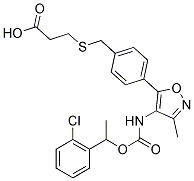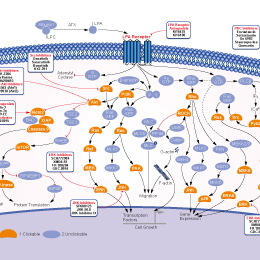
- Bioactive Compounds
- By Signaling Pathways
- PI3K/Akt/mTOR
- Epigenetics
- Methylation
- Immunology & Inflammation
- Protein Tyrosine Kinase
- Angiogenesis
- Apoptosis
- Autophagy
- ER stress & UPR
- JAK/STAT
- MAPK
- Cytoskeletal Signaling
- Cell Cycle
- TGF-beta/Smad
- DNA Damage/DNA Repair
- Compound Libraries
- Popular Compound Libraries
- Customize Library
- Clinical and FDA-approved Related
- Bioactive Compound Libraries
- Inhibitor Related
- Natural Product Related
- Metabolism Related
- Cell Death Related
- By Signaling Pathway
- By Disease
- Anti-infection and Antiviral Related
- Neuronal and Immunology Related
- Fragment and Covalent Related
- FDA-approved Drug Library
- FDA-approved & Passed Phase I Drug Library
- Preclinical/Clinical Compound Library
- Bioactive Compound Library-I
- Bioactive Compound Library-Ⅱ
- Kinase Inhibitor Library
- Express-Pick Library
- Natural Product Library
- Human Endogenous Metabolite Compound Library
- Alkaloid Compound LibraryNew
- Angiogenesis Related compound Library
- Anti-Aging Compound Library
- Anti-alzheimer Disease Compound Library
- Antibiotics compound Library
- Anti-cancer Compound Library
- Anti-cancer Compound Library-Ⅱ
- Anti-cancer Metabolism Compound Library
- Anti-Cardiovascular Disease Compound Library
- Anti-diabetic Compound Library
- Anti-infection Compound Library
- Antioxidant Compound Library
- Anti-parasitic Compound Library
- Antiviral Compound Library
- Apoptosis Compound Library
- Autophagy Compound Library
- Calcium Channel Blocker LibraryNew
- Cambridge Cancer Compound Library
- Carbohydrate Metabolism Compound LibraryNew
- Cell Cycle compound library
- CNS-Penetrant Compound Library
- Covalent Inhibitor Library
- Cytokine Inhibitor LibraryNew
- Cytoskeletal Signaling Pathway Compound Library
- DNA Damage/DNA Repair compound Library
- Drug-like Compound Library
- Endoplasmic Reticulum Stress Compound Library
- Epigenetics Compound Library
- Exosome Secretion Related Compound LibraryNew
- FDA-approved Anticancer Drug LibraryNew
- Ferroptosis Compound Library
- Flavonoid Compound Library
- Fragment Library
- Glutamine Metabolism Compound Library
- Glycolysis Compound Library
- GPCR Compound Library
- Gut Microbial Metabolite Library
- HIF-1 Signaling Pathway Compound Library
- Highly Selective Inhibitor Library
- Histone modification compound library
- HTS Library for Drug Discovery
- Human Hormone Related Compound LibraryNew
- Human Transcription Factor Compound LibraryNew
- Immunology/Inflammation Compound Library
- Inhibitor Library
- Ion Channel Ligand Library
- JAK/STAT compound library
- Lipid Metabolism Compound LibraryNew
- Macrocyclic Compound Library
- MAPK Inhibitor Library
- Medicine Food Homology Compound Library
- Metabolism Compound Library
- Methylation Compound Library
- Mouse Metabolite Compound LibraryNew
- Natural Organic Compound Library
- Neuronal Signaling Compound Library
- NF-κB Signaling Compound Library
- Nucleoside Analogue Library
- Obesity Compound Library
- Oxidative Stress Compound LibraryNew
- Plant Extract Library
- Phenotypic Screening Library
- PI3K/Akt Inhibitor Library
- Protease Inhibitor Library
- Protein-protein Interaction Inhibitor Library
- Pyroptosis Compound Library
- Small Molecule Immuno-Oncology Compound Library
- Mitochondria-Targeted Compound LibraryNew
- Stem Cell Differentiation Compound LibraryNew
- Stem Cell Signaling Compound Library
- Natural Phenol Compound LibraryNew
- Natural Terpenoid Compound LibraryNew
- TGF-beta/Smad compound library
- Traditional Chinese Medicine Library
- Tyrosine Kinase Inhibitor Library
- Ubiquitination Compound Library
-
Cherry Picking
You can personalize your library with chemicals from within Selleck's inventory. Build the right library for your research endeavors by choosing from compounds in all of our available libraries.
Please contact us at [email protected] to customize your library.
You could select:
- Antibodies
- Bioreagents
- qPCR
- 2x SYBR Green qPCR Master Mix
- 2x SYBR Green qPCR Master Mix(Low ROX)
- 2x SYBR Green qPCR Master Mix(High ROX)
- Protein Assay
- Protein A/G Magnetic Beads for IP
- Anti-Flag magnetic beads
- Anti-Flag Affinity Gel
- Anti-Myc magnetic beads
- Anti-HA magnetic beads
- Magnetic Separator
- Poly DYKDDDDK Tag Peptide lyophilized powder
- Protease Inhibitor Cocktail
- Protease Inhibitor Cocktail (EDTA-Free, 100X in DMSO)
- Phosphatase Inhibitor Cocktail (2 Tubes, 100X)
- Cell Biology
- Cell Counting Kit-8 (CCK-8)
- Animal Experiment
- Mouse Direct PCR Kit (For Genotyping)
- New Products
- Contact Us
Ki16425
Synonyms: Debio 0719
Ki16425 is a competitive, potent and reversible antagonist to LPA1, LPA2 and LPA3 with Ki of 0.34 μM, 6.5 μM and 0.93 μM in RH7777 cell lines, respectively, shows no activity at LPA4, LPA5, LPA6.

Ki16425 Chemical Structure
CAS No. 355025-24-0
Purity & Quality Control
Batch:
Purity:
99.03%
99.03
Ki16425 Related Products
| Related Targets | LPA1 LPA2 LPA3 | Click to Expand |
|---|---|---|
| Related Products | ONO-7300243 AM 095 Ki16198 | Click to Expand |
| Related Compound Libraries | FDA-approved Drug Library Natural Product Library Bioactive Compound Library-I GPCR Compound Library | Click to Expand |
Signaling Pathway
Cell Data
| Cell Lines | Assay Type | Concentration | Incubation Time | Formulation | Activity Description | PMID |
|---|---|---|---|---|---|---|
| chem1 cells | Function assay | Antagonist activity at LPA1 expressed in human chem1 cells assessed as effect on intracellular calcium mobilization by FLIPR assay, IC50=0.046μM | 20056548 | |||
| RH7777 | Function assay | Binding affinity for Lysophosphatidic acid receptor 3 expressed in RH7777 rat hepatoma cells, Ki=0.148μM | 16033271 | |||
| stellate cells | Function assay | Antagonist activity at LPA1 receptor in rat hepatic stellate cells assessed as inhibition of lysophosphatidic acid-induced intracellular calcium influx, IC50=0.16μM | 17467986 | |||
| RH7777 | Function assay | Inhibition of LPA-induced calcium transients in RH7777 rat hepatoma cells expressing LPA3 receptor, IC50=0.301μM | 16033271 | |||
| RH7777 | Function assay | Binding affinity for Lysophosphatidic acid receptor 1 expressed in RH7777 rat hepatoma cells, Ki=0.425μM | 16033271 | |||
| CHOK1 | Function assay | Antagonist activity at human recombinant LPA1 receptor expressed in CHOK1 cells assessed as inhibition of lysophosphatidic acid-induced intracellular calcium influx, IC50=0.51μM | 17467986 | |||
| RH7777 | Function assay | Inhibition of LPA-induced calcium transients in RH7777 rat hepatoma cells expressing LPA1 receptor, IC50=0.762μM | 16033271 | |||
| PC-3 | Function assay | Binding affinity for Lysophosphatidic acid receptor in PC-3 cells, Ki=1.74μM | 16033271 | |||
| PC-3 | Function assay | Inhibition of LPA-induced calcium transients in PC-3 cells, IC50=3.384μM | 16033271 | |||
| HEK293 | Function assay | 60 mins | Antagonist activity at human LPA2 receptor expressed in HEK293 cells assessed as inhibition of LPA-induced AP-TGF-alpha release treated 5 mins before LPA addition measured after 60 mins | 22658556 | ||
| HEK293 | Function assay | 60 mins | Antagonist activity at human LPA1 receptor expressed in HEK293 cells assessed as inhibition of LPA-induced AP-TGF-alpha release treated 5 mins before LPA addition measured after 60 mins | 22658556 | ||
| PC3 | Function assay | Antagonist activity at LPA receptor in human PC3 cells assessed as inhibition of LPA-induced cell migration | 22658556 | |||
| CHO | Function assay | Competitive antagonist activity at human LPA1 receptor overexpressed in CHO cells assessed as inhibition of LPA-induced [35S]GTPgammaS binding by liquid scintillation counting | 22180836 | |||
| CHO | Function assay | Competitive antagonist activity at N-terminal 3XHA-tagged human LPA3 receptor overexpressed in CHO cells assessed as inhibition of LPA-induced [35S]GTPgammaS binding by liquid scintillation counting | 22180836 | |||
| Click to View More Cell Line Experimental Data | ||||||
Biological Activity
| Description | Ki16425 is a competitive, potent and reversible antagonist to LPA1, LPA2 and LPA3 with Ki of 0.34 μM, 6.5 μM and 0.93 μM in RH7777 cell lines, respectively, shows no activity at LPA4, LPA5, LPA6. | ||||||
|---|---|---|---|---|---|---|---|
| Targets |
|
| In vitro | ||||
| In vitro | Kil6425 preferentially inhibits LPA1- and LPA3-mediated responses but has only a moderate effect on LPA2. Ki16425 inhibits the LPA-induced Ca(2+) response in THP-1 cells, 3T3 fibroblasts, and A431 cells, but had only a marginal effect in PC-12 cells and HL-60 cells, which means that Ki16425 seems to be a useful tool for evaluating the involvement of specific LPA receptors in the short-term response to LPA. Ki16425 inhibits long-term DNA synthesis and cell migration as induced by LPA in Swiss 3T3 fibroblasts. [1] Ki16425 reduces the LPA-induced activation of p42/p44 mitogen activated protein kinase (MAPK), while acting as a weak stimulator of p42/p44 MAPK on its own, properties typical of a protean agonist. Ki16425 also significantly reduces the NGF-induced stimulation of p42/p44 MAPK and inhibited NGF-stimulated neurite outgrowth in PC-12 cells. [2] Ki16425 markedly inhibits the expressions of COX-2 protein induced by synovial fluids. The enhancement of the IL-1 action by LPA on COX-2 expression is also inhibited by Ki16425. [3] | |||
|---|---|---|---|---|
| In Vivo | ||
| In vivo | Ki-16425 (30 mg/kg, i.p.) completely blocks LPA-induced neuropathic pain-like behaviors, when administered 30 min but not 90 min before lysophosphatidic acid injection, suggesting that Ki-16425 is a short-lived inhibitor. Ki-16425 also inhibits nerve injury-induced up-regulation of Caα2δ-1 in the dorsal root ganglion and reduction of SP immunoreactivity in the spinal dorsal horn. [4] | |
|---|---|---|
| Animal Research | Animal Models | Male standard ddY-strain mice are used. |
| Dosages | 30 mg/kg. | |
| Administration | Administered via i.p. | |
Chemical Information & Solubility
| Molecular Weight | 474.96 | Formula | C23H23ClN2O5S |
| CAS No. | 355025-24-0 | SDF | Download Ki16425 SDF |
| Smiles | CC1=NOC(=C1NC(=O)OC(C)C2=CC=CC=C2Cl)C3=CC=C(C=C3)CSCCC(=O)O | ||
| Storage (From the date of receipt) | |||
|
In vitro |
DMSO : 94 mg/mL ( (197.91 mM) Moisture-absorbing DMSO reduces solubility. Please use fresh DMSO.) Ethanol : 94 mg/mL Water : Insoluble |
Molecular Weight Calculator |
|
In vivo Add solvents to the product individually and in order. |
In vivo Formulation Calculator |
||||
Preparing Stock Solutions
Molarity Calculator
In vivo Formulation Calculator (Clear solution)
Step 1: Enter information below (Recommended: An additional animal making an allowance for loss during the experiment)
mg/kg
g
μL
Step 2: Enter the in vivo formulation (This is only the calculator, not formulation. Please contact us first if there is no in vivo formulation at the solubility Section.)
% DMSO
%
% Tween 80
% ddH2O
%DMSO
%
Calculation results:
Working concentration: mg/ml;
Method for preparing DMSO master liquid: mg drug pre-dissolved in μL DMSO ( Master liquid concentration mg/mL, Please contact us first if the concentration exceeds the DMSO solubility of the batch of drug. )
Method for preparing in vivo formulation: Take μL DMSO master liquid, next addμL PEG300, mix and clarify, next addμL Tween 80, mix and clarify, next add μL ddH2O, mix and clarify.
Method for preparing in vivo formulation: Take μL DMSO master liquid, next add μL Corn oil, mix and clarify.
Note: 1. Please make sure the liquid is clear before adding the next solvent.
2. Be sure to add the solvent(s) in order. You must ensure that the solution obtained, in the previous addition, is a clear solution before proceeding to add the next solvent. Physical methods such
as vortex, ultrasound or hot water bath can be used to aid dissolving.
Tech Support
Answers to questions you may have can be found in the inhibitor handling instructions. Topics include how to prepare stock solutions, how to store inhibitors, and issues that need special attention for cell-based assays and animal experiments.
Tel: +1-832-582-8158 Ext:3
If you have any other enquiries, please leave a message.
* Indicates a Required Field
Tags: buy Ki16425 | Ki16425 supplier | purchase Ki16425 | Ki16425 cost | Ki16425 manufacturer | order Ki16425 | Ki16425 distributor







































